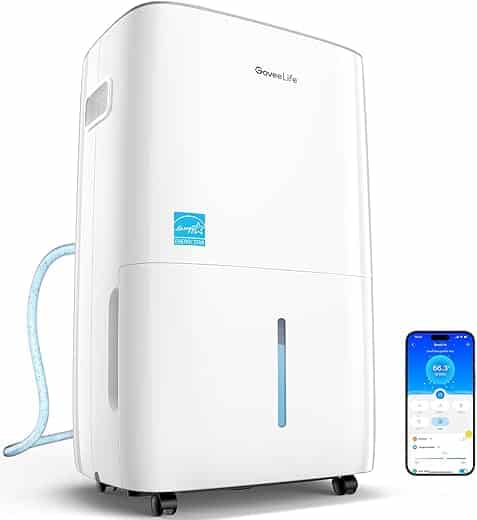


Simple Dehumidifier Repair
Understanding Smart Dehumidifiers
Smart dehumidifiers are innovative devices designed to maintain optimal humidity levels in your home while offering enhanced features that traditional dehumidifiers lack. These smart devices integrate cutting-edge technology to provide convenience and energy efficiency, making them an invaluable addition to homes, especially in humid climates.
What Are Smart Dehumidifiers?
Smart dehumidifiers are advanced versions of traditional dehumidifiers that include Wi-Fi connectivity, mobile app control, and integrated humidity sensors. Unlike their traditional counterparts, which often rely solely on manual controls and basic humidity readings, smart dehumidifiers leverage technology for improved performance and user experience.
Key Features of Smart Dehumidifiers
- Wi-Fi Connectivity: Smart dehumidifiers connect to your home Wi-Fi network, allowing you to monitor and control the device remotely through a smartphone app. You can adjust settings, turn the device on or off, and monitor humidity levels from anywhere.
- App Control: With dedicated apps (like the Frigidaire Smart App or MideaAir App), you can easily manage your dehumidifier, receive alerts, and view humidity history. Brands such as hOmeLabs and TOSOT offer models that provide robust app functionalities, giving you control at your fingertips.
- Integrated Humidity Sensors: Smart dehumidifiers often come with built-in humidity sensors. This means they can automatically adjust their operation based on real-time humidity levels. For example, the hOmeLabs 50 Pint Dehumidifier employs advanced sensors to maintain optimal humidity, ensuring your space remains comfortable without excessive energy consumption.
- Energy Efficiency: Many smart dehumidifiers, such as the GE Energy Star Portable Dehumidifier, are designed with energy-efficient features that not only save you money on your electricity bill but also reduce your carbon footprint. These models are capable of automatically powering down when the desired humidity level is reached, preventing energy waste.
How Smart Dehumidifiers Differ from Traditional Models
| Feature | Smart Dehumidifiers | Traditional Dehumidifiers |
|---|---|---|
| Wi-Fi Connectivity | Yes | No |
| App Control | Yes | No |
| Humidity Sensors | Automatic adjustments | Manual settings only |
| Energy Efficiency | High; can adjust based on need | Varied; typically less efficient |
| Monitoring Capabilities | Real-time data via app | Basic indicators (e.g., humidity gauge) |
Benefits of Smart Dehumidifiers
Smart dehumidifiers offer numerous benefits that enhance convenience and effectiveness:
- Convenience: With app control, adjustments can be made from anywhere in your home or even while you’re away. This means you don’t have to walk to the device to set or change the humidity level.
- Enhanced Monitoring: Many smart dehumidifiers provide real-time humidity readings and notifications, allowing you to stay informed about your home’s environment. For instance, the Midea Cube Dehumidifier sends alerts when water tanks are full or needs maintenance, giving you peace of mind.
- Custom Settings: Smart models often allow you to set specific humidity levels, such as keeping a basement at a consistent 50% humidity, which is key in preventing mold and mildew.
- Data Tracking: The ability to view historical humidity data helps you identify patterns and make informed decisions about humidity management in your home.
- Remote Troubleshooting: As most smart dehumidifiers are linked to apps, manufacturers can provide remote diagnostics, meaning issues can often be addressed without a costly service call.
Practical Examples of Smart Dehumidifiers
Several brands stand out in the smart dehumidifier market:
By incorporating smart technology, these dehumidifiers not only offer better performance than traditional models but also enhance user experience through convenience, advanced monitoring capabilities, and energy savings. Whether you need to protect your home from excess moisture or improve air quality, smart dehumidifiers provide the perfect solution tailored to modern living.


Common Issues Encountered
Smart dehumidifiers, designed to help maintain optimal humidity levels and improve air quality, can encounter various issues that may affect their performance. Understanding these common problems can prepare you for troubleshooting and enhance your overall experience. Below, we discuss several frequent challenges users face while using smart dehumidifiers like the Frigidaire FFAP5033W1 and the hOmeLabs HME020031N.
Connectivity Problems
Explanation
One of the primary features of smart dehumidifiers is their connectivity to mobile apps for remote monitoring and control. However, some users report issues connecting to their Wi-Fi networks, which can hinder the usage of these features.
Causes
Troubleshooting Steps
Water Leakage
Explanation
Water leakage can be a frustrating issue, especially if it leads to water damage in your home.
Causes
Troubleshooting Steps
Insufficient Dehumidification
Explanation
Users may notice that their smart dehumidifiers are not effectively reducing humidity levels, which is particularly concerning in damp climates.
Causes
Troubleshooting Steps
Noise Levels
Explanation
While most modern dehumidifiers, such as the hOmeLabs HME020031N, are designed to operate quietly, some users report that their units are noisier than expected.
Causes
Troubleshooting Steps
Error Messages
Explanation
Seeing an error message on the display panel can be alarming, as it might indicate a malfunction or troubleshooting need.
Common Error Codes for Popular Models
| Model | Error Code | Description |
|---|---|---|
| Frigidaire FFAP5033W1 | E1 | Humidity sensor failure |
| hOmeLabs HME020031N | E2 | High humidity warning |
| De’Longhi DNH-450 | E3 | Water tank issue (full or improperly placed) |
Troubleshooting Steps
Summary of Common Issues
By understanding these common issues and their potential solutions, users can ensure that their smart dehumidifiers function effectively, providing a comfortable and healthy home environment.


Troubleshooting Tips
When you encounter issues with your devices, it can be frustrating. However, with a bit of guidance, many problems can be resolved quickly and easily. Below, we provide detailed troubleshooting steps for common issues such as connectivity problems, water leakage, and performance-related challenges.
Connectivity Issues
Connectivity troubles can prevent your devices from functioning properly. Here’s how to troubleshoot these frequently encountered problems:
Resetting the Device
- Unplug the device from the power source.
- Wait for 30 seconds.
- Plug it back in and turn it on to see if the issue is resolved.
Checking the Wi-Fi Signal
If your device relies on Wi-Fi, ensuring a strong connection is crucial. Here’s how to check:
Example Devices for Easy Connection Troubleshooting:
| Device | Suggested Troubleshooting Steps |
|---|---|
| Amazon Echo | Restart the Echo by unplugging and then plugging it back in. |
| Canon PIXMA Printer | Ensure the printer is connected to Wi-Fi through the Canon app. |
Handling Water Leakage
Water leakage can lead to more significant problems if not addressed quickly. Below are steps to troubleshoot commonly affected appliances:
Checking the Water Tank
- Inspect the water tank for cracks or improper seating. Devices like the Keurig K-Elite Coffee Maker can leak if the tank isn’t aligned correctly.
- Remove and clean the water tank to ensure no debris is causing the leak.
Inspecting Hose Connections
Quick Leak Detection Tips:
Addressing Performance-Related Problems
If your device isn’t performing as expected, follow these troubleshooting tips to enhance its functionality.
Adjusting Settings
- Refer to the user manual to ensure all settings are appropriately configured. A common example is the Dyson V11 Torque Drive Vacuum, which has multiple cleaning modes for different types of floors.
- Consider resetting factory settings if problems persist. For instance, to reset the Google Nest Hub, press and hold the volume buttons until it announces a reset.
Cleaning Filters
Dirt and dust can significantly hinder a device’s performance.
Performance Improvement Checklist:
| Device | Additional Actions |
|---|---|
| Instant Pot Duo 7-in-1 | Ensure the steam release valve is closed properly. |
| iRobot Roomba 675 | Empty the dustbin and clean the brushes regularly. |
These actionable troubleshooting steps should help resolve many common issues you may face with your devices. By following these guidelines, you can minimize downtime and get back to enjoying seamless functionality.
Summarizing Solutions to Enhance Your Smart Dehumidifier Experience
In conclusion, smart dehumidifiers are valuable tools for enhancing indoor air quality, but they are not without their challenges. Recognizing the common issues and employing the suggested troubleshooting strategies can empower users to maximize their devices’ functionality. Nevertheless, should problems continue, it is advisable to consult a professional to guarantee the smart dehumidifier’s optimal performance and durability.



Leave a Reply